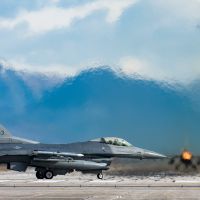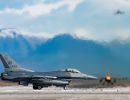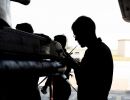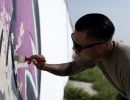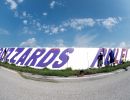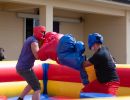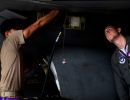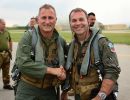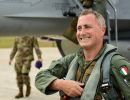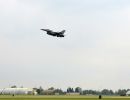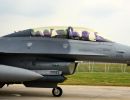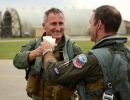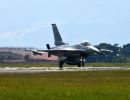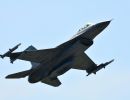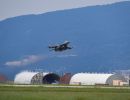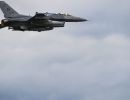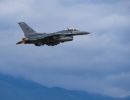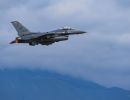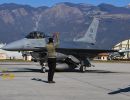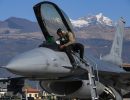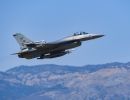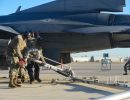The 31st Fighter Wing, 555th Fighter Squadron, and 510th Fighter Squadron have forged a proud tradition of excellence—excellence in the air, on the ground, at the front and behind the lines, in operations, in maintenance, and in support. These three squadrons share a common history of distinct courage, heroism, and sacrifice. Their glory is now ours.
Our story begins 36 years before the United States Air Force was established, even before many of the men you are about to meet were born…in the cradle of the Italian Air Force—Aviano.
In 1920, Aviano was officially named Aeroporto Pagliano e Gori, to honor Capt. Maurizio Paglian and Lt. Luigi Gori. In their Caproni biplane, they made an unauthorized, but successful raid on the Austrian naval yards in Pola during World War I. They were killed a year later flying a strafing mission.
As Hitler was secretly rebuilding Germany’s Air Force, selected pilots came to Aviano for flight instruction.
Laster, units of the German Luftwaffe and Italian Air Force would be based here during World War II.
But as Italian pilots feverishly train for battle…the men of the 510th Fighter Squadron are also undergoing flight instruction in preparation for war.
Though the Buzzards would fly many aircraft, it was Alexander Cartveli’s patented P-47 Thunderbolt that would bring the Nickel Dime Squadron World War II fame.
The 510th arrived at Christchurch, England in March, 1944. Their mission—support allied ground forces and destroy enemy material. Of the 122 pilots, 18 would be killed in action and 32 would be shot down. 7 became prisoners of war. Howard Curran would become their only ace.
Pilot Bill Simpkins: "I joined in the first week of May. There wasn’t much good action until "D" Day. That’s when all hell broke loose. The people upstairs in command turned us loose and we did our bit."
Simpkins flew 101 missions. Buddies Jimmy Pelletier and George Quinlan were killed in action.
On "D" Day morning 16 Thunderbolts took off from the wiremesh runway at Christchurch. The planes were equipped with auxiliary fuel tanks, 500 pound bombs, and 450 rounds of 50 caliber ammo for each of eight guns.
Michael O’Reagan survived a bail-out, but broke both legs. While spending 6 months as a prisoner of war in a German hospital he went from 147 to 86 pounds. "He was a survivor and one hell of a good pilot."
The 510th's first wartime commander Major Bruce Parcell. He and his squadron synchronized their watches at a predawn briefing. Mission: the St. Lo bombing allowing ground forces to break out o f Cherbourg. Two missions later, Parcell’s plane was hit by heavy flak on a strafing run and he was killed.
The Nickel Dime Squadron moved to Picauville, France. They lived in tents near the landing strip. The 826th Engineering Squadron bulldozed a thirty eight hundred foot clearing through an apple orchard, covered it with tarpaper, and had it operational in under 5 days.
Commander Ralph Jenkins now led the 510th and set a record of 130 missions. His Thunderbolt was painted by assistant G-2 clerk Sgt. Lynn Trank.
Buzz Norr finished the war with 4 aerial victories in 3 days and received the silver star. Trank painted Norr a Pilot’s Dream. He painted all the planes—except for Bill Simpkins’. Once recording 57 flak holes on one mission—Simpkins figured it was a waste of time.
While in Normandy the 510th constructed an officers’ Club from latrine screens and artillery shell crates. Flak Haven was reactivated in Bentwaters, England in the 1980s.
The squadron flew 4,861 missions. In 11 months they shot down 107 enemy aircraft, and destroyed 199 tanks, 2,092 train cars, 264 gun emplacements, 12 bridges, and 449 buildings.
Mechanics who worked in winter with numbed hands on delicate engine changes, paper shufflers who specialized in office machinery, cooks, cops, and communicators were just as critical to victory as the steel-nerved pilots.
One historic tribute to the singular accomplishments of the 510th reads: "I feel that especial emphasis should be placed on the truly heroic action of the 510th Fighter Bomber Squadron which on September 24, in support of the 4th Armored Division, took off in unflyible weather, uncertain whether or not they could ever land. This unit intervened at the critical moment of a tank battle, and by their skill and daring very materially assisted in the defeat and destruction of the enemy." Signed George S. Patton, Jr., Lt. General U.S. Army, Commanding.
The World Famous Highly Respected 555th Triple Nickel Tactical Fighter Squadron moves to Udorn, Thailand February 1966. They will become the world’s largest distributor of MiG parts in Southeast Asia.
On leaving his wife Capt. Dean Weihe says: "Now I shall know what kind of man I really am. I’m a poor student, struggling athlete, but a fifteen hundred miles per hour and 6,000 feet, or slashing towards a target, I’m an outstanding fighter pilot and that will keep me alive."
Participating in Air-to-Ground and Air-to-Air missions between April 23 and May 12, 6 Nickel crews down 6 enemy planes. The 555th became the first Ace Squadron in Southeast Asia—just 3 months after arrival.
Now based at Ubon, Thailand, pilot Lt. Jerry Jameson was a one-month veteran. Flying through MiG Alley near Hanoi, he was spotted by 5 enemy MiGs. Diving 5000 feet in mere seconds he and… Lt. Doug Rose shot down one enemy plane with a Sidewinder missile. For Jameson and Rose there remain 11 months and at least 85 missions with the Triple Nickel. But this time they win.
LTC Jess Allen, 555th commander, led the first strikes against North Vietnamese air fields in April 67.
By June the Nickel was a Triple Ace Squadron with 15 kills. Each star on their flag records a downed MiG.
World War II ace Col. Robin "Stash" Olds: "We out-flew, we out-shot, and we out-fought them." Olds celebrates the first of 4 kills, 2 as a Nickel member, during Operation BOLO January 1967. Later he would command the 8th Tactical Fighter Wing Wolfpack, recording more than 100 missions over North Vietnam. Olds would retire a brigadier General.
Pilot Richard Pascoe: "The MiG was rolling back and forth. I was low and he couldn’t see me. As he pulled up I had a perfect line on his silhouette." It was the second kill for Pascoe and copilot Capt. Norman Wells.
Night bombing attacks against North Vietnam begin in October. Capt. Bill Gordon and Lt. Jim Monsees down their first MiG. While in Ubon the 555th downed 14 more aircraft making them the only Quad Ace Squadron in Southeast Asia.
Capt. Don Logeman and Lt. Fred McCoy downed a Mig-17 with an Aim-7 missile.
McCoy then presented a plaque from the Wolfpack’s mustached men to Bob Hope during his annual Christmas tour.
"Once Green Always Green," the traditional Nickel toast to new commander, Doc Dougherty, April 68. Traditional drink, Green Death: one shot each of vodka, creme de menthe, and Jeremiah Weed.
The 555th returns to Udorn and Capt. William Gordon sends a personal message from his hometown of Wethersfield, Connecticut.
Tom McInerney and back-seater Roger Gossic refuel during a mission. Lt. General McInerney would later head the Alaskan Air Command.
Nickel pilots averaged two thousand five hundred flying hours. No other Squadron in Southeast Asia amassed a record to equal the 555th. They adopted the acronym W.F.H.R. (World Famous Highly Respected) to denote the pride and camaraderie among Triple Nickel members. Having 3 nickels in your possession at all times a requirement.
Triple, nicknamed Trip, was born under the aircrew quarters and adapted by the 555th as their mascot. She slept in the briefing room bookcase and rode in the commander’s jeep. Trip spent many hours escorting crews to their planes and greeting them on their return.
The two names most often associated with the Nickel and Pilot Ritchie and his Wizzo DeBellvui.
5 Aces emerged from the Vietnam conflict. Capt. Steve Ritchie was the first. He bagged his 5th MiG while passing canopy to canopy at almost supersonic speed.
The 555th was the only squadron to produce 2 aces. Capt Chuck Bellevue was not only the highest scoring ace, but the only Weapons System Officer and GIB—guy in back—to attain that honor.
In a wild dogfight with 4 MiGs Roger Locher’s plane was hit after downing his 3rd MiG. He ejected but his pilot, Major Bob Lodge, went down with the plane. Locher survived for 23 days behind enemy lines.
Morrison and Mravak weren’t so lucky. Along with many other Nickel members they made the ultimate sacrifice.
The 555th was awarded the Hughes Trophy in January 1974, only the 2nd tactical squadron to receive that honor. Recognized for 2 Air Force crosses, 19 silver stars, 100 Distinguished Flying Crosses, and 288 Air Medals in 1973 alone, the 555th would end the war with 40 enemy kills. Their achievements were made possible by the sustained maximum effort of maintenance and support units. Nickel members accepted the Hughes Trophy in tribute to all fighter units in Southeast Asia, with a special dedication to the memory of those men who gave their lives.
This story that began in Aviano does not end here—but begins a new chapter as the 31st Fighter Wing stands poised, ready to make new history.


